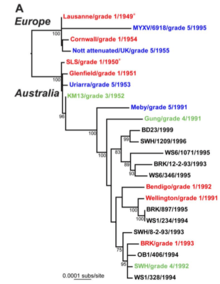Myxoma virus
| Myxoma virus | |
|---|---|
| Virus classification | |
| Group: | Group I (dsDNA) |
| Family: | Poxviridae |
| Genus: | Leporipoxvirus |
| Species: | Myxoma virus |
Myxoma virus is a virus that causes myxomatosis in rabbits and was used as a pest control in Australia.
Structure
Virions are enveloped, and have a surface membrane with lateral bodies. The envelope contains host-derived lipids and self-synthesized glycolipids. They are brick-shaped and about 250 nm in diameter, 300 nm in length and 200 nm in height. The middle contains a biconcave core which appears to be characteristic to many poxviruses.
Genome

The genome is nonsegmented and contains a single molecule of linear, double-stranded DNA, 160000 nucleotides in length. The genome has a G-C content of ~40%, with terminally redundant sequences which are repeated at both ends.[2]
The genome encodes 170 open reading frames, twelve of which are duplicated in the terminal inverted repetitions.[1]
Infection and pathology
During their normal life cycles, virions produce extracellular and intracellular proteins. The extracellular proteins are used primarily for suppressing or circumventing the host immune responses, hence are nonessential. Infection is also initiated by extracellular virions. The myxoma virus matures naturally by budding through the surface membrane of the host cell.[3]
The myxoma virus has multiple methods that it utilizes to evade the immune system. One route of protection involves blocking the caspase activity within the host cells. The E13L viral protein is able to inhibit the caspases by binding to the CARD protein, which is part of the caspase-1-activating inflammasome complex.[4] By binding it is able to inhibit apoptosis, which is normally induced by the CARD protein.[4] In addition, the myxoma virus utilizes the Serp-2 viral gene to inhibit a variety of other capsases.[4] The Serp-2 gene is also capable of inhibiting granzyme B, a cysteine protease.[4]
The myxoma virus is also capable of producing tumor necrosis factor receptor mimics to reduce the host's natural response to TNF. The M-T2 protein is a soluble receptor the mimics the TNF receptors within rabbits.[5]
Pathology in rabbits
Most rabbit and hare hosts are susceptible to the virus, which means the virus can effectively evade the host immunity. However, susceptibility is not the primary indicator for symptomatic infection or pathology. A distinction must be made between susceptibility and permissibility, in which only the latter must be true before the virus is able to replicate in the cell and cause pathologies. This is the reason the myxoma virus is very species-specific; it is able to circumvent a certain species of rabbit's immune response, but is unable to do so for any other species. However, the virus is able to get into the cells of many different species including human, mouse, and monkey, which is generally useless if it is unable to replicate and avoid the immune system.
In 1993, the Australian government approved a modification of the myoxoma virus that would introduce genetic code into rabbit sperm and egg proteins. This mutation would induce an autoimmune response and inhibit fertility.[6] This immunocontraceptive vaccine is still being tested for wild release.
References
- 1 2 Kerr, Peter; Ghedin, Elodie; et al. (2012), "Evolutionary History and Attenuation of Myxoma Virus on Two Continents", PLoS Pathogens, 8 (10), doi:10.1371/journal.ppat.1002950
- ↑ Cheryl Cameron et al. (25 November 1999). "The Complete DNA Sequence of Myxoma Virus.". Virology. 264 (2): 298–318. doi:10.1006/viro.1999.0001.
- ↑ ICTVdB Management (2006). 00.058.1.05.001. Myxoma virus. In: ICTVdB—The Universal Virus Database, version 4. Büchen-Osmond, C. (Ed), Columbia University, New York, USA.
- 1 2 3 4 Mahy, Brian W J; Van Regenmortel, Marc H (2008), The Encyclopedia of Virology, I (3rd ed.), San Diego, CA: Academic Press, p. 161
- ↑ Mahy, Brian W J; Van Regenmortel, Marc H (2008), The Encyclopedia of Virology, I (3rd ed.), San Diego, CA: Academic Press, p. 157
- ↑ Shors, Teri (2013). Understanding Viruses (Second ed.). Burlington, MA: Jones & Bartlett Learning. p. 438. ISBN 9781449648923.